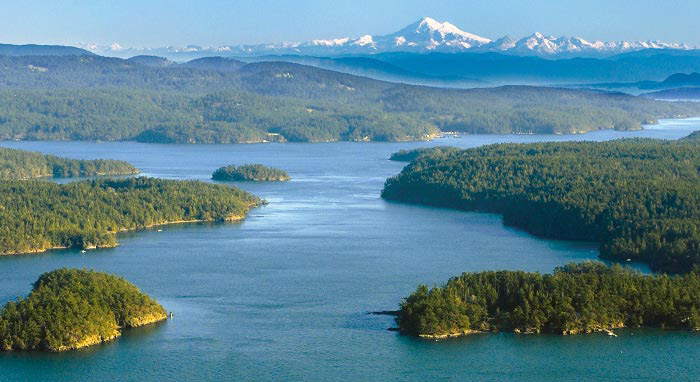STORMWATER RUNOFF STILL MAIN THREAT TO PUGET SOUND
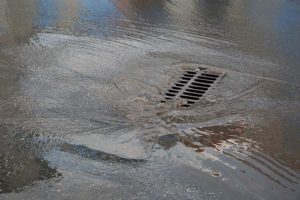 As kids growing up in Tacoma in the 50’s and early 60’s, we didn’t think twice about driving cars that either burned oil or leaked badly.
As kids growing up in Tacoma in the 50’s and early 60’s, we didn’t think twice about driving cars that either burned oil or leaked badly.
We didn’t pay much attention to where our dogs pooped (our yard or the neighbors), what we washed our cars with, or how we disposed of old chemicals, pesticides, fertilizer, or oil.
After all, we reasoned, it’s Washington, it will be gone after a few good rains.
That’s why no one thought much when you dropped a cigarette butt on the ground, let alone what the impact would be if you paved your gravel driveway or parking lot.
It wasn’t that we were slobs or uncaring, just a fact that no one educated us about the effects our actions would have on Commencement Bay and a pristine Puget Sound over the next 50 years.
Seemed like the only time we heard about pollution in Commencement Bay back then, it was due to the pulp plants or Tacoma Smelter – all of which have long since shut down.
Of course, we did not envision that the population of Tacoma would grow to 207,876 by 2015 and that Pierce County overall would swell from 275,876 in 1950 to nearly 900,000 residents today (per U.S. Census).
Combined with other major cities and counties bordering Puget Sound, the population went from 1.8-million in 1960 to more than 4.4-million by 2008. Washington State’s Office of Financial Management now estimates 5.1-million will make the Puget Sound region their home by 2020.
DRAMATIC GROWTH TAKES ITS TOLL
As a result of this growth and development, nearly 70% of Puget Sound salt marshes, eelgrass beds, and estuaries were damaged or lost to development over the past 125 years and more than 30% of Puget Sound’s 2,500 miles of shoreline were reinforced by seawalls, bulkheads, and other structures that destroyed habitat for young salmon and other marine life, according to the Washington State Department of Ecology
While most did not predict this kind of population growth and urbanization in our lifetime, we also failed to foresee the dramatic impact it would have on one of the world’s most fragile estuary systems and that we would reach the point where the water that washes off our roads, roofs, and “developed areas” is now the leading environmental threat to Puget Sound.
“It’s the main culprit and leading cause of pollution in Commencement Bay and Puget Sound,” City of Tacoma Environmental Services engineer Shauna Hansen affirmed. “And dealing with storm water is a very complex problem with no single solution.”
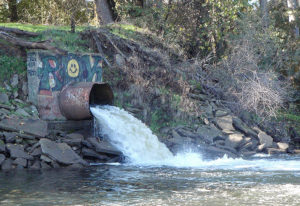 STORM WATER NOW DELIVERS MOST POLLUTION TO THE SOUND
STORM WATER NOW DELIVERS MOST POLLUTION TO THE SOUND
In support of Hansen’s statement, storm water runoff now accounts for more than 75% of all pollution in Puget Sound, per the Puget Sound Partnership, a state agency created to coordinate the efforts of state, federal, local governments and Tribes, as well as dozens of non-profit citizen groups involved in the “recovery” of Puget Sound since passage of the federal Clean Water Act in the early 1970’s.
Even though most commercial and industrial development has been regulated extensively under some of the most stringent water quality standards in the nation since the early 1990’s, by 2008 the Washington State Department of Ecology reported that 549 streams, rivers, and lakes in the Puget Sound basis were impaired by “poor water quality,” mostly from polluted storm water runoff.
Even today, the Department of Ecology estimates that Puget Sound still “receives millions of pounds of toxic chemicals every year from surface runoff, groundwater discharges, and municipal and wastewater outfall pipes” containing oil, grease, PCB’s, phthalates, copper, lead, zinc, and other toxins that concentrate in urban bays and now threaten the state’s $147-million per year commercial and recreational fish industry as well as the $9.5-billion tourism industry.
PUGET SOUND ON THE BRINK
“The rate of damage to Puget Sound continues to exceed the rate of healing. That’s a pattern we need to change,” Puget Sound Partnership Executive Director Sheida Sahandy noted in regards to one of several bills introduced over the years to provide increased funding, resources, and protection for Puget Sound as the largest estuary in the United States by water volume, a waterbody of national significance on par with the Chesapeake Bay and Great Lakes.
In order to change the pattern, most experts agree we need to habits and how we think about storm water pollution runoff.
“Most people think storm water is treated like waste water or sewage, but it’s not,” Hansen explained. “For the most part, all surface and storm water runs unabated into the Sound.”
WHAT HITS THE GROUND GOES UNTREATED INTO THE SOUND
In general, storm water systems are not the same as “wastewater” systems that process human waste and sewage and treat it before releasing into the Sound. Storm Water systems basically catch, channel, and divert surface water runoff directly into Puget Sound untreated.
For most of Puget Sound (including Tacoma), the two systems are not connected due to the high runoff volumes in a region that receives 39+ inches of rain each year. Sewage treatment plants that are connected to storm pipes are often overrun with storm water during peak rain periods, thus sending raw sewage into the Sound along with the untreated storm water.
That’s why the City of Tacoma Environmental Services has a separate Surface Water Management division to operate and maintain 66,000 surface water accounts, 500 miles of public storm water pipe, 22,000+ catch basins, four pump stations and numerous detention ponds and structures that all deal with surface runoff alone.
Environmental Services also oversees Solid Waste Management (garbage, recycling, food/yard waste) as well as Wastewater Management systems, with more than 700 miles of sewer pipe that feed two treatment plants that process 10 billion gallons of waste water each year.
Compounding Tacoma’s Surface Water Management challenge is the fact the city deals with miles of Puget Sound shoreline, a very active Port of Tacoma, and tons of various pollutants, garbage, and debris that flow down the Puyallup River and other natural drainages directly into the Port and into Commencement Bay.
HOW DO WE STOP THE FLOW?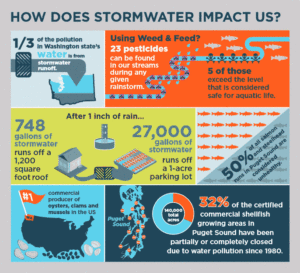
At this point in time, it is impractical to build treatment plants that can capture all storm water, treat and remove all the various forms of pollution (from animal waste to road oil and pesticides) before reaching the Sound – the price would be “astronomical,” Hansen admits.
“It’s a big soup of everything, never just one element causing more problems than others,” Hansen revealed “And, it can vary from storm to storm. If we have a long period without rain, we tend to see more oils and toxins associated with paved surfaces.”
And, it’s not just the dirt, oil, plastics, and other residue that wash off the roadways that are polluting surface runoff, everything from dog poop to home and farm pesticides are adding fuel to the fire. Even the soaps we wash our cars with or the cigarette butts we casually discard are having major effects.
“You would not think a cigarette butt would be that big of a deal, but they all add up,” Hansen said. “We’ve even seen small floating islands of cigarette butts on occasion, which are very toxic to marine life.”
With no single solution that can deal with all forms of surface water pollution, most efforts to clean up Puget Sound are focused on preventing pollution before it reaches water in the first place, as well as restoring sites already affected by industry and urbanization.
Housed at the Center for Urban Waters on East D Street in Tacoma, the city’s Environmental Services Department conducts dozens of outreach programs to educate residents on how they can help mitigate surface water pollution as well as coordinate and directly manage various restoration projects.
REPORTING POLLUTION IS FIRST STEP
“The first and most important thing is to simply report it,” Hansen said. “If you see any kind of pollution or potential to pollute surface or storm water, please give us a call so we can deal with it before it becomes a huge problem.”
Besides operating a 24-hour City of Tacoma Water Pollution Hotline (253-383-2429), Environmental Services provides information on how to: Prevent/Report street flooding and pollution; hire a sustainable landscape professional; volunteer to mark storm drains; host a eco-friendly car wash; or learn how to use rain barrels, rain gardens, plants and trees to mitigate runoff effects at home or in a local neighborhood.
In some cases, the city also provides Sewer Conversion Loans (converting septic tanks to city sewer systems) as well as Environment Services Sponsorships for organizations and events that protect, enhance or restore Tacoma’s environment. The city also awards up to $50,000 a year alone in Make-A-Splash grants to help educate residents and protect and restore surface water resources within Tacoma city limits.
EDUCATING THE PUBLIC IS TOP PRIORITY
A shining example of a community effort to reduce storm water pollution is FixCarLeaks.org, a non-profit organization that maintains a website with information on how to spot car leaks or, better yet, schedule a free inspection or workshop on how to properly maintain your vehicle. Auto leaks of oil, coolants, brake and transmission fluids are the largest polluters of Puget Sound.
The City of Tacoma, as well as most counties, municipalities, Tribes, non-profit organizations, and agencies that are dedicated to combating pollution in Puget Sound, also participate in “Puget Sound Starts Here” (www.pugetsoundstartshere.org), an ongoing regional public awareness campaign that hopes to get more people involved cleaning up and restoring the Sound.
Besides education and outreach programs to curb the increase in storm water pollution, Tacoma Environmental Services also conducts ongoing restoration and monitoring of critical watersheds, habitat, and storm water systems.
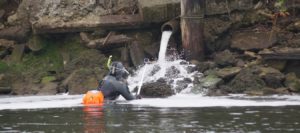 RESTORATION PROJECTS HAVE DELIVERED SURPRISING RESULTS
RESTORATION PROJECTS HAVE DELIVERED SURPRISING RESULTS
Tacoma recently celebrated the 10th anniversary of completion of the $105-million cleanup of the Thea Foss and Wheeler-Osgood waterways that removed contaminated sediment leftover from the old Smelter and Pulp Mill days and restored shoreline habitats throughout Commencement Bay, which are now continually monitored to ensure they stay clean.
“It’s amazing to think of what these areas were like only 20 years ago, they have come a long way,” Hansen points out.
The Port of Tacoma has also stepped up its storm water pollution mitigation efforts over the past several years as runoff has taken a greater importance and focus in the permitting process for existing and new industrial customers in what is now one of the most regulated water ways in the world.
For example, State Department of Ecology permits now require all industrial transportation facilities to minimize metals (cooper, zinc, etc.) and sediment pollutants in storm water runoff, not just separate the oil from the water as in the old days.
For the most part, this requires processing storm water runoff or preventing pollution in the first place by controlling the source, which can present a serious challenge to an industrial area like a maritime port.
Though its Northwest Seaport Alliance with the Port of Seattle, NWSA now employs several environmental specialists and engineers that work with tenants to recommend treatment projects and systems as well as test new and existing treatment methods to find the best solutions for a maritime environment.
NECESSITY IS THE MOTHER OF INVENTION
At the present time, both ports have functional clean water projects underway, including SSA Marine’s multi-year, multi-million-dollar effort to improve storm water treatment at the 200-acre Terminal 18 in Seattle, where the terminal operator is developing three wetland projects and a unique Chitosan Enhanced Sand Filteration system that uses a huge tank filled with sand and oyster shells to treat storm water.
SSA Marine also recently installed 23 large wooden “rain garden” planters and “rain barrels” along Terminal 18 building downspouts to catch and filter all roof storm water runoff before entering the Sound. Not only is this solution highly effective and cost-effective, it’s esthetically pleasing.
At the Port of Tacoma, several innovative storm water treatment projects have also been implemented, including a four-stage, 600-foot-long biofiltration system at the West Hylebos Terminal that can also remove pollutants. The Port of Tacoma’s intermodal yard also implemented a “jellyfish” system in 2014 to also assist in clean water efforts.
And, an on-going pilot project to retrofit an oil/water separator at the breakbulk terminal at East Blair in the Port of Tacoma is designed to filter out metals from water. Once completed and tested, this cost-effective ($25,000) solution can be provided to other NWSA partners and properties.
A LONG WAY TO GO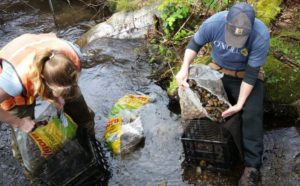
“Though we have accomplished a lot over the past decade, we still have a long way to go,” Hansen surmised. “And, we can only get there if every person helps in one way or another in preventing the causes for storm water pollution in the first place.”
Though large scale government and industrial prevention and restoration efforts are helping, the fact still remains the majority of storm water pollution comes from our roads, driveways, and back yards, not industrial and commercial use.
Which means we can only recover Puget Sound if we fix our car leaks, pick up the pet poop, wash our cars at eco-friendly car washes, pick up our litter, plastic bottles, cigarette butts, and look over our homes to make sure rain water that comes from your roof finds its way to the proper storm drain, or better yet, a water garden in your yard.
WHAT CAN I DO?
As a recently retired Senior with some spare time on his hands, volunteering to assist any one of dozens of non-profit groups devoted to the recovery of Puget Sound may prove to be a very rewarding experience and a way to atone for the misdeeds of my youth.
Both the Tacoma Environmental Services department or the Puget Sound Starts Here websites list dozens of resources, seminars, and events that can all use volunteers to help get the word out.
 Take, for example, Citizens For A Healthy Bay (www.healthybay.org), one of the leading non-profit citizens groups that is focused entirely on Commencement Bay. They sponsor numerous cleanup events where you can get your hands dirty, as well as state educational and awareness events.
Take, for example, Citizens For A Healthy Bay (www.healthybay.org), one of the leading non-profit citizens groups that is focused entirely on Commencement Bay. They sponsor numerous cleanup events where you can get your hands dirty, as well as state educational and awareness events.
They also coordinate bay patrols with volunteer boat owners always on the lookout pollution in Commencement Bay.
RESOURCES
City of Tacoma Environmental Services – www.cityoftacoma.org/government/city_departments/environmentalservices/
Center for Urban Waters
326 East D Street
Tacoma, WA 98421
(253) 591-5588
POLLUTION HOTLINE: (253) 383-2429 (leave confidential message 24-hours a day)
STORM DRAIN FLOODING: (253) 591-5585 (24-hours a day)
Washington State Department of Ecology – www.ecy.wa.gov
Puget Sound Partnership – www.psp.wa.gov
Puget Sound Starts Here – www.pugetsoundstartshere.org
Northwest Seaport Alliance – www.nwseaportalliance.com
Environment Washington – www.environmentwashington.org
Citizens For A Healthy Bay – www.healthybay.com
FixCarLeaks.Org – www.fixcarleaks.org
Puget Sound Keeper – http://www.pugetsoundkeeper.org/2015/04/13/stormwater-survey-what-we-learned/
